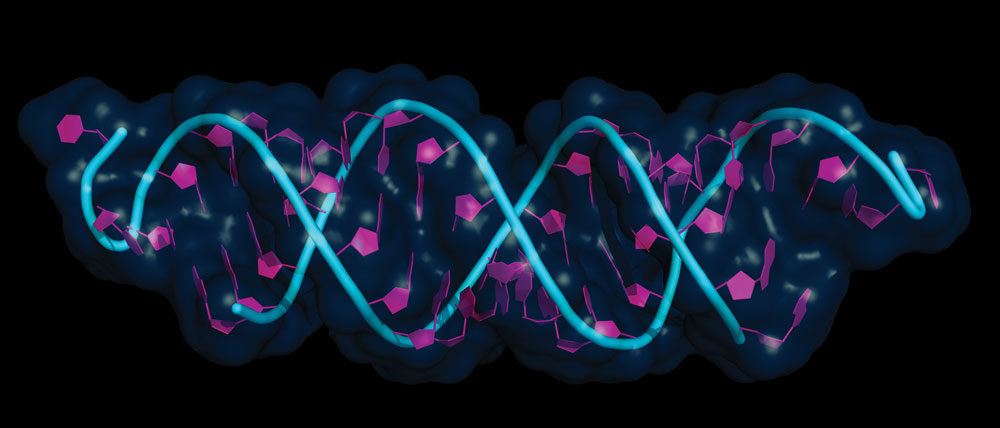Pictured Above: RUNNING INTERFERENCE. RNA interference (RNAi) technology is making its way into the world of agriculture. SmartStax PRO, a new product from Bayer, contains RNAi technology to help combat an uptick in resistance to Bt traits.
Through natural selection, insects and other pests continue to thwart efforts to control them, developing resistance to sprays, seed treatments and even plant-incorporated protectants (PIPs). Corn rootworm (CRW), for example, has recently begun shrugging off some of the Bt traits introduced starting in 2003 to control it.
Taking a simplified historical view, this adaptation is very rapid, especially considering that the main previous method of CRW control — crop rotation — delayed resistance for decades.
RNAi Technology
The introduction of Bt corn reduced the impacts of CRW considerably, but with that technology now facing challenges, scientists have turned to a new biotech tool — RNA interference (RNAi).
In fact, in 2017 Bayer’s SmartStax PRO, a GM corn seed featuring an RNAi-based mode of action, became the first RNAi insect control product to be approved by the EPA and just recently achieved approval for import and food/feed use from China, opening the door to a 2022 commercial release.
Using RNAi technology is promising because it can be deployed in a very targeted way. According to Graham Head, head of global resistance management for Bayer, “RNA interference allows one to target particular aspects of an insect’s biology and use that to control them.
“By using this technology, we’re able to look at the genes that are most important to the corn rootworm life cycle, pick one that is critical to the overall metabolism of the insect — in this case DvSnf7 — and we can completely knock it out,” he says.
One of the keys to this process is the “interference” aspect, which as the name suggests, means that after being ingested and absorbed, it interferes with the insect’s ability to create a specific protein. This “leads to the insect ceasing to feed within a day or two, causing mortality shortly after because the insect isn’t able to feed,” Head says.
SmartStax PRO doesn’t just rely on RNAi technology and contains other Bt traits that have appeared in previous SmartStax products — Cry3Bb1, Cry34/35Ab1, Cry1A.105 + Cry2Ab2 and Cry1F.
Like any insect control agent, Head emphasizes that it should be used in conjunction with other management practices, such as crop rotation, incorporating refuges and field scouting.
Looking into the future, Head says he believes RNAi has got good potential for additional product development but it does have limitations.
“For reasons the scientific community doesn’t fully understand yet, when RNAi technologies are used, they have very clear efficacy in beetle pests. But, for example, in moths they don’t seem to work,” he says.
Bayer did field testing with SmartStax PRO during the 2019 and 2020 growing seasons, testing it against a non-CRW trait and many commercial trait packages that contain the leading traits for CRW protection that are on the U.S. market today, including its own.
They targeted fields with moderate-to-high corn rootworm CRW pressure, including fields that previously had greater than expected damage (GTED), were on multiple years of corn-on-corn and/or other factors that caused CRW pressure to be moderate to high over 2019-2020.
Results showed that SmartStax PRO statistically outperformed all other products in the trial. While other traits with CRW protection did provide better performance than the check, they also had significantly more damage than SmartStax PRO technology.
“RNA interference allows one to target particular aspects of an insect’s biology and use that to control them…” – Graham Head, Bayer’s head of global resistance management
The early results for this new RNAi mode of action look promising. Whether it remains effective for the long run only time will tell, as one key to prolonging the efficacy is adoption of integrated pest management by growers that employs a variety of pest-control technologies.
“Fundamentally, we view the diversity of tools as being absolutely critical for grower success and for management of a pest like rootworm. It’s important that farmer have access to the broadest availability of tools,” says Head.
New Modes of Action
Access to a good selection of single-site pesticides has, unfortunately, led to dwindling efficacy over the years. And a challenging regulatory environment means fewer new products are in the pipeline to replace those that become ineffective. But new modes of action are still being developed and offer growers some promising solutions.
• Vayantis Fungicide: The pathogen Pythium poses a significant disease threat in corn seedlings, and with more than 50 Pythium species, it’s a leading cause of yield loss in corn, according to Dale Ireland, technical product lead for Syngenta Seedcare.
With a completely new mode of action, Syngenta’s Vayantis fungicide contains the active ingredient picarbutrazox, a new systemic fungicide seed treatment developed to protect seedlings from key blight and damping-off diseases such as Pythium and Phytophthora.
In trials, Vayantis was shown to help increase potential yield by 4-6 bushels per acre in moderate to high disease pressure situations when compared to other seed treatments.
• Teraxxa seed treatment: Wireworms are becoming an increasing problem for cereal growers. A rapidly expanding population can devastate a young wheat crop, causing a seedling loss of up to 50%. To combat this threat, BASF released Teraxxa, a new seed treatment containing broflanilide, a new class of chemistry: Insecticide Resistance Action Committee (IRAC) Mode of Action Group 30.
Broflanilide binds to the wireworm’s central nervous system causing hyperactivity of nerves and muscles, which ultimately eliminates the pest. Trials show it to be highly effective with rapid wireworm mortality on contact across all species and life stages, with field studies showing an 80-90% reduction.
Multiple Modes of Action
While new modes of action are few and far between, integrated approaches to pest management are gaining ground. With the aim of maintaining the usefulness of existing chemicals, companies are releasing more products containing multiple modes of action.
• Vive Azterknot Fungicide: AZterknot fungicide from Vive Crop Protection is a three-way fungicide combination that the company says blends a biologicals, a chemical and a nano-polymer technology that allows previously incompatible products to be mixed together.
Registered in a broad range of crops for soil and foliar applications, AZterknot provides the plant health and disease control benefits of two active ingredients: Reynoutria (giant knotweed) extract and azoxystrobin.
These two modes of action combine with Vive’s patented Allosperse technology to address the inherent compatibility issues when combining biologicals and chemicals, providing handling ease and efficiency, systemic disease control and activation of the plant’s natural defense mechanisms.
• Huskie FX: A new formulation added to the Huskie family of herbicides combines three modes of action to make one simple solution for weed resistance management for cereal growers. Huskie FX includes three active ingredients, with fluroxypyr, pyrasulfotole and bromoxynil.
Recent trial data demonstrated the use of Huskie FX enabled enhanced control of broadleaf weeds and excellent control of kochia in spring wheat compared to other herbicide programs on the market.
• Acuron GT: A new herbicide for glyphosate-tolerant corn, Acuron GT combines Halex GT corn herbicide with the active ingredient bicyclopyrone (BIR). The combination of four active ingredients and three sites of action in Acuron GT helps growers manage weeds longer into the season to fully protect yield potential and minimize the weed seed bank for next year’s crop.
“Compared to Halex GT, field trials show Acuron GT provided an 8% increase in residual control of annual grass and small-seeded broadleaf weeds and a 14% increase in residual control of Palmer amaranth when evaluated 42-56 days after treatment,” says Scott Cully, a Syngenta scientist based in Illinois.
Acuron GT may help growers achieve almost 90% control of weeds 6-8 weeks after post-emergence application, a true testament to the residual power of BIR, according to the company.







